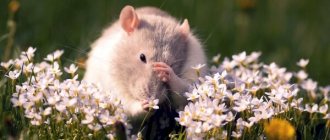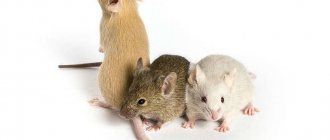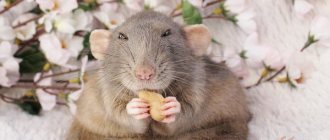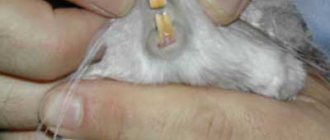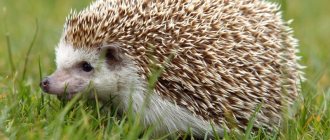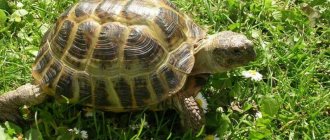What does it look like
These rodents are quite small in size - the length of the largest individual is approximately 14-15 cm, and the size of the small mice is 7 cm.
This representative is distinguished by an elongated and pointed muzzle, round eyes and large ears.
The tail of the mammal is hairless, with small fluff and ring-shaped scales. The length of the tail is almost equal to the size of the animal’s body. The fur is short and quite smooth.
The color of the animal depends on its habitat: mice that live in deserts are sandy or brown, rodents that live in the north are usually grayish or black.
The hind legs with clawed toes are longer than the front ones: there are four in front and 5 in the back.
Description of the rodent
— Advertising —
The body length of the house mouse is 6.5-9.5 cm. The length of the tail is about 60% in relation to the length of the body, its surface is covered with horny scales, which are arranged in rings, as well as short sparse hairs. The weight of adult individuals is from 12 to 30 g. The ears are round and small. The fur is dark or brownish-gray, the belly is ash-gray or white. Desert mice are lighter in color, their fur is yellowish-sandy, and their bellies are white. Domesticated mice come in white, black, yellow, blue-gray and variegated colors. Females have 5 pairs of nipples.
Backbone
The skeleton of the animal, although light, is very strong, elastic and mobile.
Mice have a skull and part of the muzzle that are slightly elongated; places of fusion of bones appear on the skull. The most prominent bones are the parietal, lamboid, interparietal, parietotemporal, coronoid, and frontal.
In this article you can see what small mice look like.
The lower jaw of the animals is developed and can move in different directions.
The spine of rodents consists of 5 parts, in particular:
- 7 cervical vertebrae;
- 13 thoracic vertebrae;
- 7 lumbar;
- 4 sacral;
- 20 tail.
The brisket is quite narrow in size - it has 13 paired ribs.
Flight
The arm with the wing is driven by several paired muscles of the upper girdle, which, to reduce energy consumption for flight are attached not to the sternum, but to the fibrous base of the wing. The keel of the sternum of animals is inferior in power to that of birds: only one muscle necessary for flight is attached to it - the pectoralis major.
The flight speed of animals usually does not exceed 20 km/h . The record holder is the Brazilian folded lip: its flight speed reaches 100 km/h. Some species are able to fly away for the winter , covering more than 300 km . Read about how bats winter.
The spine of flying mammals is more mobile than that of birds . It allows mice to be more maneuverable outside the air.
Dental system
These mammals have two pairs of well-developed incisors on each jaw. They don't even have roots in front and grow throughout their lives. The upper ones are larger in size than those located below, they are protected by strong enamel.
The mouse fangs on the jaw are replaced by a toothless edge - a diastema; behind it are molars, some of them smooth, others lumpy. Thanks to them, parasites grind food. Molars are constantly growing and need to be ground down.
If an animal wants to gnaw on an iron or hard object, they are able to break off the lower incisors from below, this risks the fact that the teeth on the upper jaw will bend inward, thus the mammal will not close its mouth without having eaten.
Structure
Birds have adapted to flight thanks to lightweight cellular bones, air sacs in the lungs, and feathers that are heterogeneous in structure and function. Flying bats do not have all this , and the skin membranes can hardly be called wings.
How do bats fly? The flight of mice is similar to the flight of the flying machine of Leonardo da Vinci , who adopted from nature the idea of the structure of the wing of a flying mammal.
A solid membrane of skin, impenetrable by air, “covers” the air masses from above, which allows the animals to push off from them and fly.
Internal organs
Let's take a closer look at the internal organs. The animal's trachea is located in the cervical region, followed by the esophagus. The thyroid gland is located in the area of the larynx, and a little lower, near the sternum, is the thymus gland. The secretion is released into the blood thanks to these endocrine glands.
The heart valve and lungs are located in the sternum.
Note that a dome-like diaphragm is found only in rodents. It seems to separate the sternum from the peritoneum.
The liver is located under the diaphragm, it is also like a dome. On the left side and slightly below the liver is the stomach, from which the loops of the small intestine branch off.
In the middle of the intestine you can see the lateral outgrowth of the cecum. Note that this organ is quite highly developed in mammals that feed on plant foods. Then comes the large intestine and anus.
In males, testes in the shape of ellipses are located at the bottom of the abdominal cavity. In individuals that have reached puberty, they lie in the scrotum.
Wolffian canals branch off from the testes - ducts into which the ducts of the seminal vesicles flow. Depending on their size, the male will be successful or unsuccessful in breeding. The genital organ is clearly visible.
In female individuals we can see the uterus. In those females who have not yet reached puberty, the uterine horns are very thin, barely noticeable. But for those who have already given birth to offspring, they are wide. The embryo is clearly visible in the uterus of pregnant female mice.
Kinds
The mouse subfamily is one of the most numerous, it includes more than 500 species of rodents, which are combined into 121 genera. Let's look at a few of the most common varieties.
Harvest mouse
Field mice are one of the largest groups of rodents. The size of voles ranges from 8 to 12 cm. You can recognize a field mouse by its color; its fur is brownish-brown, often with reddish markings, a rather wide dark stripe is visible on its back, and light gray fur on its belly. These rodents live in Europe, China, Mongolia, and Korea.
Typically, field mice live in open spaces - fields, meadows. There they dig shallow burrows or colonize existing natural shelters. Sometimes voles can settle in garden plots and even enter houses.
The field mouse is cautious and timid, and practically does not detect its presence. You can most often hear these mice squeaking only if they are caught in a trap.
House mouse
The house mouse is a rather small species, the body size of the animals is from 6.5 to 9 cm. The color is dark, brownish-gray, the abdomen is light. House mice have perfectly adapted to living near humans. They can live in houses, bathhouses, and outbuildings.
House mice are the most common species, as they settled across all continents along with people. These rodents are found everywhere, with the exception of the Far North, Antarctica and high mountain areas.
Herbal
One of the largest representatives of the mouse subfamily. The body size can reach 15 – 18 cm, the tail length is slightly less. The coat is elongated, grayish-brown.
Herbal
The homeland of these rodents is Southeast Africa. They live both in the savannah and in tropical bushes. Often found in pastures, gardens, and floodplains. Grass mice, unlike their relatives, lead a diurnal lifestyle.
Lesnaya
The wood mouse got its name because, unlike its relatives, it chooses mixed and deciduous forests for living. It can be found in steppes and even on rocky areas. In nature, the wood mouse tries to occupy natural shelters (empty holes of other animals, voids between stones, rotten stumps), but if necessary, it also digs holes.
The rodent's body length is 8–10 cm, the length of the tail is almost equal to the length of the body. The color is reddish-gray, the fur on the belly is lighter. A distinctive feature is a small yellowish spot on the chest.
Gerbil
Gerbils are a separate subfamily, in which there are more than 100 species of rodents. The body length of the gerbil, depending on the species, is from 6 to 20 cm, the tail length is from 6 to 24 cm. The color is dull, inconspicuous, most often the coat is sandy or muted brown. The difference from most of its relatives is its long, well-furred tail.
Habitat: arid steppes, deserts and semi-deserts. Gerbils are predominantly diurnal and do not hibernate in winter, but become more lethargic in winter.
Shrew
It is very easy to distinguish shrews from other mice. These rodents have a long, strongly pointed muzzle with a slightly curved nose at the end. Shrews are small rodents with thick fur of an ash-gray, reddish or buffy hue.
They prefer to live in places with high humidity; some species lead a semi-aquatic lifestyle. They occupy the burrows of other animals or dig their own in the ground. They can build nests under fallen trees or dead wood, in rotten stumps, and sometimes settle next to humans.
Yellowthroat
The yellow-necked mouse is a small rodent, the size of which rarely exceeds 10 cm. The color is quite bright, brownish-red, and there is a yellow stripe around the neck, from which the mouse got its name. Another feature of this variety is its large, rounded ears.
Yellowthroat
The distribution area is almost all of Europe and Western Asia. Most often, mice live in open clearings of mixed and deciduous forests, but they can also be found in city parks, gardens and personal plots.
Sense and smell organs
Since these animals lead an active lifestyle at night, their visual organs are poorly developed. As scientists have found, rodents can distinguish between red and yellow colors.
Mice are endowed with excellent hearing - small tailed parasites can even hear high-frequency sounds.
At night or in a dark room, they navigate the area with the help of their antennae - vibrissae. The organ of smell plays an important role in the life of rodents - thanks to the excellent organ of smell, they distinguish friend from foe, find food and determine their location in space.
There are special glands on the paws that secrete a secretion, this substance helps them mark their territory.
When a mouse is frightened or stressed, a special substance appears in its urine; it gives a signal to other relatives about impending danger so that they can run away.
Dream
Representatives of bats sleep upside down . With the claws of their hind legs, they cling to a horizontal crossbar or a tree branch, press their wings to their body and fall asleep. Why do bats sleep upside down (upside down)? They do not sleep while sitting: the weak bones of the lower extremities cannot withstand hours of stress on them during sleep.
Sleeping bats, sensing danger, spread their wings, unclench the claws of their hind legs and fly away without wasting time getting up from a lying or sitting position.
Features of life
Rodents are active all year round, so they constantly accumulate provisions for the winter. However, house animals settle into human housing, where you can always get something to eat. As a rule, in the summer, mice move into the fields, and closer to winter they again occupy residential buildings.
Wild pests are active mainly at night, but this factor depends on climate conditions. They do not like heat, and closer to the onset of cold weather they become more active during the day.
The mouse’s body can even go without water for a long time, because their body itself is able to secrete the required amount of moisture.
Enemies of mice
The mouse is the most important link in many food chains. For some animals, mice are the main source of food. The main enemies of mice:
- snakes and large lizards;
- mammals (cats, foxes, small mustelids, mongooses, wolves, badgers, hedgehogs);
- birds (owls, eagles, owls, kites, hawks, crows).
Sometimes mice become victims of their close relatives - rats. Yes, and the answer to the question can a mouse eat a mouse is also yes. This happens very rarely, but mice deprived of the opportunity to get food can attack their weaker relatives.
And, of course, we must not forget about the main enemy of house mice – humans.
Histology of skeletal muscle
Skeletal muscle fibers are significantly different from other body tissues due to their highly specialized functions. Many of the organelles that make up muscle fibers are unique to that cell type. The sarcolemma is the cell membrane of muscle fibers. The sarcolemma acts as a conductor for electrochemical signals that stimulate muscle cells. Connected to the sarcolemma, transverse tubules (T-tubules) help carry electrochemical signals to the middle of the muscle fiber
The sarcoplasmic reticulum serves as a storehouse for calcium ions (Ca2+), which are vital for muscle contraction. Mitochondria, the driving force of the cell, are found in abundance in muscle cells to provide energy in the form of ATP to active muscles. Most of the muscle fiber structure is made of myofibrils, which are the contractile structures of the cell.
Myofibrils are composed of many protein fibers arranged in repeating subunits called sarcomeres. The sarcomere is the functional unit of muscle fibers.
Sarcomere structure
Sarcomeres are made from two types of protein fibers: thick filaments and thin filaments. Thick filaments are made up of many linked units of the myosin protein. Myosin is a protein that causes muscles to contract. The thin filaments are made up of three proteins:
Actin. Actin forms a helical structure that makes up most of the mass of the thin filament. Tropomyosin. Tropomyosin is a long fibrous protein that wraps around actin and encloses myosin, binding to actin. Troponin. A protein that binds very tightly to tropomyosin during muscle contraction.
Reproduction
How do bats reproduce and are born? Before hibernation, animals open the mating season (how and where do bats hibernate?). A few months after mating, 1-2 mice are born , which the mother feeds with milk for 2 weeks.
Bat cubs are under the care of their mother for 3 weeks , after which they begin to live independently. Ask how long bats live; there is evidence that bats can live up to 30 years .

